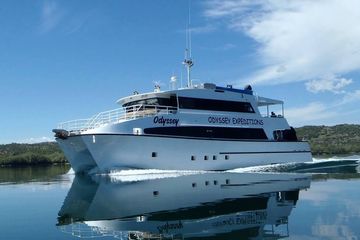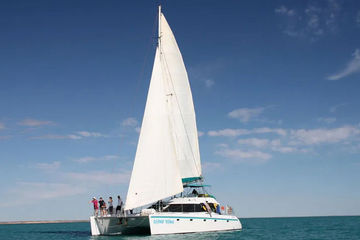Snorkeling in Western Australia
Snorkeling in Western Australia
Snorkelling in Western Australia is defined by the incredibly species diverse waters of the Indian Ocean. Many of the reef formations found along Western Australia are reachable by a short swim or quick boat ride from the pristine beaches. Western Australian snorkelling includes the world's longest fringing reef, found at Ningaloo, where over 520 species of fish have been counted. In addition to fringing reefs, snorkel sites include shallow lagoons with beautifully coloured coral gardens, mangroves, and of course, barrier reefs.
Western Australia is the second largest country subdivision in the world, and occupies the entire western third of Australia, covering an impressive 2.5 million square kilometres. To the north and west, you will be snorkelling in the Indian Ocean, while the Great Australian Bight and the Southern Ocean are found to the south.
2 Snorkeling Cruises in Western AustraliaExplore all liveaboards
Marine life in Western Australia
Snorkel sites in Western Australia are teeming with marine life. Six of the seven species of sea turtle can be seen here, many of whom use the nearby shores as breeding grounds. Several of the larger species who also visit include humpback whales and whale sharks, manta rays, dugong and the potato cod, which can reach lengths in excess of 8 feet and weigh over 100 kg. It's also possible to see the incredibly fast sailfish, that has clocked speeds of over 100 km/h. Coastal mangroves serve as the breeding ground for many species of fish, mostly reef fish, providing excellent shelter against predatory species like barracuda.
Best snorkel sites in Western Australia
The best snorkel sites in Western Australia are perhaps Rowley Shoals, Ningaloo Reef and the Montebello Islands:
Rowley Shoals is just north of Broome, and lies within Rowley Shoals Marine Park. It sits on the edge of one of the widest continental shelves in the world. A staggering 688 species of fish have been recorded here, and well as 233 coral species. As well as shallow lagoons and impeccable corals, it is also possible to see wrecks. Several pelagic species are frequent visitors to the reefs, including schools of trevally and tuna, while the Napoleon wrasse gives up the protection of the mangroves to become one of the largest reef species, reaching lengths of over 6 feet.
Ningaloo Reef has been designated a UNESCO World Heritage site for its incredible biodiversity, covering an area of over 70 000 square kilometres. Over 300 coral varieties have been identified here, in addition to its high fish species count, and it is the location of the world's longest fringing reef at over 260 km in length. Coral Bay is a particularly popular snorkel site, with coral gardens found in shallow water. Pinnacles of corals are often accompanied by many encircling reef fish, while moray eels find shelter in small cracks and crevices.
Montebello Islands feature some of the highest biodiversity in the world. Species counts include over 450 fish, 150 corals. 630 molluscs, and 170 sea stars, urchins and echinoderms. The shallow nature of the reefs allows for the most stunning photos to be taken effortlessly. It is possible to see dugongs and dolphins around these picturesque islands, and over 10 species of whale have been sighted. The shores of the islands are used by both green and hawksbill turtles as nesting sites, while sailfish wait in slightly deeper water, keeping an eye out for easy prey.
Best time to snorkel in Western Australia
Snorkelling in Western Australia is possible throughout most of the year. To the north, the climate is similar to that of the tropics and is driest from November until March. This is most pertinent for Ningaloo Reef and Montebello Islands, which are located to the north. Although, humpback whales migrate in this area between June and November, while turtle hatching season lasts from January until February. Whale sharks also pass through Ningaloo on their migratory routes between March and mid-July. The southern half of Western Australia has a Mediterranean climate and the best conditions for a snorkel trip to Rowley Shoals will be between September and December.
How do I get to Western Australia?
The best way to reach your snorkel tour in Western Australia is to fly to Perth International Airport. Long haul flights will typically connect through Bangkok, Singapore or Dubai, depending on your departure location. Once in Perth, it is possible to catch a short haul flight to your final destination. For Rowley Shoals and the Montebello Islands to the north, Broome International Airport provides the nearest access point, while it is recommended to fly to RAAF Learmonth Airport for liveaboards sailing to Ningaloo Reef on the west coast.








